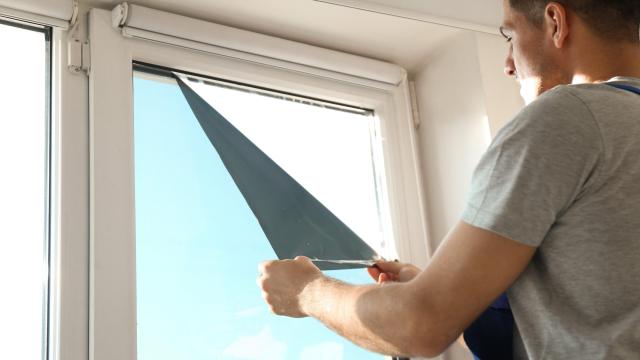When you hear “tinted windows,” you probably think first of cars — and the various degrees to which you can tint their windows within (or outside of) the law. But you can tint your home’s windows, too, without the pesky legal drama — and you might want to.
Why tint your home’s windows?
There are plenty of reasons to tint the windows of your home, starting with the fact that the sun is so damn bright and probably wakes you up earlier than you’d like on Saturday mornings. But window tinting is broken down into three categories: Solar tinting, security tinting, and decorative tinting.
Solar tinting provides UV protection but doesn’t have a dark look. Security tinting includes layers of polyester film that can help protect against break-ins. And decorative tinting just helps your windows look nicer. You can do these for privacy, to darken a space, or to protect you from invaders, whether they’re thieves or UV rays.
Tinting can also add to the resale value of your home — and save you a little money while you’re still living in it.
“Something people don’t know is tinting your home windows is an investment that pays dividends,” said Lewis Goldberg Jr., owner and installer at the Window Tinters in New Jersey. “Just reducing heat in the summer and having an added layer of insulation on the glass for the winter will reduce your utility bills.”
How common is window tinting?
Home window tinting isn’t as well-known as automotive window tinting, but loads of people still opt for it. Goldberg has been tinting windows for 12 years and has noticed an increase in customers requesting the service, but added that the spike is regional.
In sunnier places, he said, “it’s a big necessity just for solar control.” In other areas, it’s seen as more of a luxury. But even if it’s not excessively sunny where you live, he said, “everyone’s home can benefit from blocking harmful UV rays.”
What goes into it?
You can certainly do this yourself, but you need to know what you’re getting into. It’s not particularly easy, but you can save a little money if you opt to tackle the project yourself. You need to know what kind of tint you want, buy the right film, measure your windows, cut the film, and clean your glass, all before even starting the real project. Tip: Add an inch to your measurements all around the glass so you have some wiggle room in case you make a mistake.
Peel the backing off and attach the tint, but remember that like any sticker or wallpaper, it can fold in and get stuck to itself. Two sticky sides meeting will be difficult to pry apart, and you might have to buy more tint than you bargained for if your first few pieces get stuck.
Read the instructions on your film to understand how it works. Is it water-activated or does something else activate the adhesive? And don’t forget that once you place it, you have to carefully remove the bubbles under the film and trim the edges without scratching the glass.
“As easy as a professional may make it appear, only a true professional knows how to safely install tints and has access to films that are backed by warranties,” said Goldberg. Yeah, warranties. See? There’s a lot that goes into this!
If you end up seeking out a professional, expect to pay for their expertise.
“Depending on the type of film, the distance travelled, and the difficulty, a professional residential tint job can range $US10 ($14)-$US15 ($21) a square foot,” said Goldberg, noting that hard-to-reach windows can add on to costs. Some specialty films, like transitional window tinting, can be as much as $US36 ($50) per square foot.
Of course, you don’t have to tint the windows of the whole home — there might be certain rooms that benefit from tinted windows while the windows in other rooms are perfectly fine to remain au naturale.

Leave a Reply
You must be logged in to post a comment.